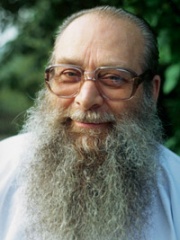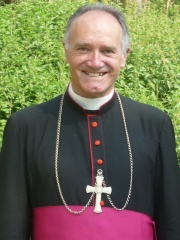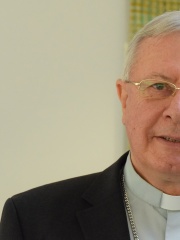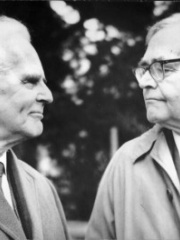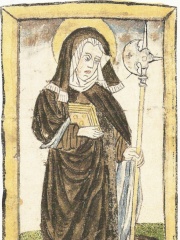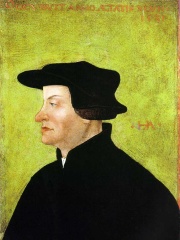
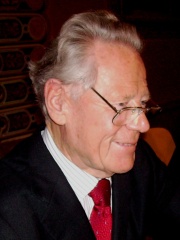
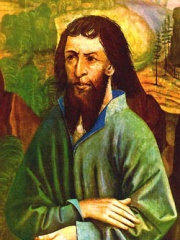
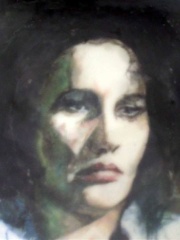
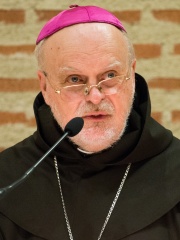
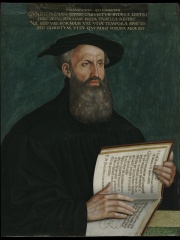
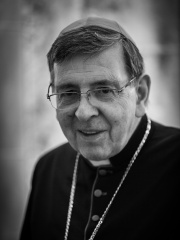

The Most Famous
RELIGIOUS FIGURES from Switzerland
This page contains a list of the greatest Swiss Religious Figures. The pantheon dataset contains 3,187 Religious Figures, 28 of which were born in Switzerland. This makes Switzerland the birth place of the 18th most number of Religious Figures behind Iran, and Japan.
Top 10
The following people are considered by Pantheon to be the top 10 most legendary Swiss Religious Figures of all time. This list of famous Swiss Religious Figures is sorted by HPI (Historical Popularity Index), a metric that aggregates information on a biography's online popularity. Visit the rankings page to view the entire list of Swiss Religious Figures.

1. Huldrych Zwingli (1484 - 1531)
With an HPI of 81.35, Huldrych Zwingli is the most famous Swiss Religious Figure. His biography has been translated into 86 different languages on wikipedia.
Huldrych or Ulrich Zwingli (1 January 1484 – 11 October 1531) was a Swiss Christian theologian, musician, and leader of the Reformation in Switzerland. Born during a time of emerging Swiss patriotism and increasing criticism of the Swiss mercenary system, he attended the University of Vienna and the University of Basel, a scholarly center of Renaissance humanism. He continued his studies while he served as a pastor in Glarus and later in Einsiedeln, where he was influenced by the writings of Erasmus. During his tenures at Basel and Einsiedeln, Zwingli began to familiarize himself with many criticisms Christian institutions were facing regarding their reform guidance and garnered scripture which aimed to address such criticisms. In 1519, Zwingli became the Leutpriester (people's priest) of the Grossmünster in Zurich where he began to preach ideas on reform of the Catholic Church. In his first public controversy in 1522, he attacked the custom of fasting during Lent. In his publications, he noted corruption in the ecclesiastical hierarchy, promoted clerical marriage, and attacked the use of images in places of worship. Among his most notable contributions to the Reformation was his expository preaching, starting in 1519, through the Gospel of Matthew, before eventually using Biblical exegesis to go through the entire New Testament, a radical departure from the Catholic mass. In 1525, he introduced a new communion liturgy to replace the Mass. He also clashed with the Anabaptists, which resulted in their persecution. Historians have debated whether or not he turned Zurich into a theocracy. The Reformation spread to other parts of the Swiss Confederation, but several cantons resisted, preferring to remain Catholic. Zwingli formed an alliance of Reformed cantons which divided the Confederation along religious lines. In 1529, a war was averted at the last moment between the two sides. Meanwhile, Zwingli's ideas came to the attention of Martin Luther and other reformers. They met at the Marburg Colloquy and agreed on many points of doctrine, but they could not reach an accord on the doctrine of the Real Presence of Christ in the Eucharist. In 1531, Zwingli's alliance applied an unsuccessful food blockade on the Catholic cantons. The cantons responded with an attack at a moment when Zurich was ill-prepared, and Zwingli died on the battlefield. His legacy lives on in the confessions, liturgy, and church orders of the Reformed churches of today.

2. Hans Küng (1928 - 2021)
With an HPI of 71.34, Hans Küng is the 2nd most famous Swiss Religious Figure. His biography has been translated into 43 different languages.
Hans Küng (German: [ˈhans ˈkʏŋ]; 19 March 1928 – 6 April 2021) was a Swiss Catholic priest, theologian, and author. From 1995 he was president of the Foundation for a Global Ethic (Stiftung Weltethos). Küng was ordained a priest in 1954, joined the faculty of the University of Tübingen in 1960, and served as a theological adviser during the Second Vatican Council. In 1978, after he rejected the doctrine of papal infallibility, he was not allowed to continue teaching as a Catholic theologian, but he remained at Tübingen as a professor of ecumenical theology until he retired with the title professor emeritus in 1996. He remained a Catholic priest until his death. He supported the spiritual substance of religion, while questioning traditional dogmatic Christianity. He published Christianity and the world religions: paths of dialogue with Islam, Hinduism, and Buddhism in 1986, wrote Dying with Dignity together with Walter Jens in 1998, and signed the appeal Church 2011, The Need for a New Beginning. He was awarded honorific doctorates internationally, and received numerous awards including the Otto Hahn Peace Medal in 2008.

3. Nicholas of Flüe (1417 - 1487)
With an HPI of 68.93, Nicholas of Flüe is the 3rd most famous Swiss Religious Figure. His biography has been translated into 23 different languages.
Nicholas of Flüe (German: Niklaus von Flüe; 1417 – 21 March 1487) was a Swiss hermit and ascetic who is the patron saint of Switzerland. He is sometimes invoked as Brother Klaus. A farmer, military leader, member of the assembly, councillor, judge and mystic, he was respected as a man of complete moral integrity. He is known for having fasted for over twenty years. Brother Klaus's counsel to the Diet of Stans (1481) helped prevent war between the Swiss cantons.

4. Anna Göldi (1734 - 1782)
With an HPI of 68.54, Anna Göldi is the 4th most famous Swiss Religious Figure. Her biography has been translated into 26 different languages.
Anna Göldi (also Göldin or Goeldin, 24 October 1734 – 13 June 1782) was a Swiss housemaid who was one of the last persons to be executed for witchcraft in Europe. Göldi, who was executed by decapitation in Glarus, has been called the "last witch" in Switzerland. She was posthumously exonerated by the government of the canton of Glarus in 2008.
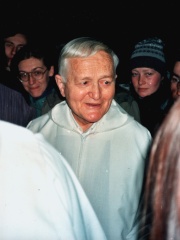
5. Brother Roger (1915 - 2005)
With an HPI of 68.17, Brother Roger is the 5th most famous Swiss Religious Figure. His biography has been translated into 34 different languages.
Roger Schutz (12 May 1915 – 16 August 2005), popularly known as Brother Roger of Taizé (French: Frère Roger), was a Swiss Christian leader and monastic brother. In 1940 Brother Roger founded the Taizé Community, an ecumenical monastic community in Burgundy, France, serving as its first prior until his murder in 2005. Towards the end of his life, the Taizé Community was attracting international attention, welcoming thousands of young pilgrims every week, which it has continued to do after his death.

6. Anders Arborelius (b. 1949)
With an HPI of 68.16, Anders Arborelius is the 6th most famous Swiss Religious Figure. Her biography has been translated into 29 different languages.
Lars Anders Cardinal Arborelius (Swedish: [ˈânːdɛʂ arbʊˈrěːlɪɵs]; born 24 September 1949) is a senior-ranking Swedish Catholic prelate who has served as Bishop of Stockholm since 1998. Pope Francis made him a cardinal, the first ever from Scandinavia, in 2017. He is a member of the Discalced Carmelites and was considered a candidate in the 2025 papal conclave.

7. Heinrich Bullinger (1504 - 1575)
With an HPI of 66.05, Heinrich Bullinger is the 7th most famous Swiss Religious Figure. His biography has been translated into 33 different languages.
Heinrich Bullinger (18 July 1504 – 17 September 1575) was a Swiss Reformer and theologian, the successor of Huldrych Zwingli as head of the Church of Zürich and a pastor at the Grossmünster. One of the most important leaders of the Swiss Reformation, Bullinger co-authored the Helvetic Confessions and collaborated with John Calvin to work out a Reformed doctrine of the Lord's Supper.

8. Kurt Koch (b. 1950)
With an HPI of 65.78, Kurt Koch is the 8th most famous Swiss Religious Figure. His biography has been translated into 28 different languages.
Kurt Koch (born 15 March 1950) is a Swiss prelate of the Catholic Church. He has been a cardinal since November 2010 and president of the Dicastery for Promoting Christian Unity since 1 July 2010. He was the bishop of Basel from 1996 until 2010.

9. Jakob Ammann (1644 - 1730)
With an HPI of 65.51, Jakob Ammann is the 9th most famous Swiss Religious Figure. His biography has been translated into 28 different languages.
Jakob Ammann (also Jacob Amman, Amann; 12 February 1644 – between 1712 and 1730) was a Swiss Anabaptist leader and the namesake of the Amish religious movement.
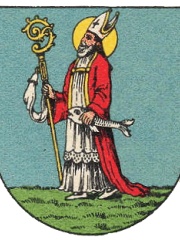
10. Ulrich of Augsburg (890 - 973)
With an HPI of 64.90, Ulrich of Augsburg is the 10th most famous Swiss Religious Figure. His biography has been translated into 23 different languages.
Ulrich of Augsburg (890 – 4 July 973), sometimes spelled Uodalric or Odalrici, was Prince-Bishop of Augsburg in the Holy Roman Empire. He was the first saint to be canonised not by a local authority but by a Pope.
People
Pantheon has 28 people classified as Swiss religious figures born between 689 and 1958. Of these 28, 5 (17.86%) of them are still alive today. The most famous living Swiss religious figures include Anders Arborelius, Kurt Koch, and Billy Meier. The most famous deceased Swiss religious figures include Huldrych Zwingli, Hans Küng, and Nicholas of Flüe.
Living Swiss Religious Figures
Go to all RankingsAnders Arborelius
1949 - Present
HPI: 68.16
Kurt Koch
1950 - Present
HPI: 65.78
Billy Meier
1937 - Present
HPI: 63.70
Bernard Fellay
1958 - Present
HPI: 56.98
Paul Hinder
1942 - Present
HPI: 49.96
Deceased Swiss Religious Figures
Go to all RankingsHuldrych Zwingli
1484 - 1531
HPI: 81.35
Hans Küng
1928 - 2021
HPI: 71.34
Nicholas of Flüe
1417 - 1487
HPI: 68.93
Anna Göldi
1734 - 1782
HPI: 68.54
Brother Roger
1915 - 2005
HPI: 68.17
Heinrich Bullinger
1504 - 1575
HPI: 66.05
Jakob Ammann
1644 - 1730
HPI: 65.51
Ulrich of Augsburg
890 - 973
HPI: 64.90
Jacob Sprenger
1435 - 1495
HPI: 63.12
Emil Brunner
1889 - 1966
HPI: 62.54
Henri Schwery
1932 - 2021
HPI: 61.67
Wiborada
900 - 926
HPI: 61.67
Overlapping Lives
Which Religious Figures were alive at the same time? This visualization shows the lifespans of the 12 most globally memorable Religious Figures since 1700.

